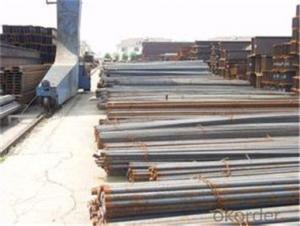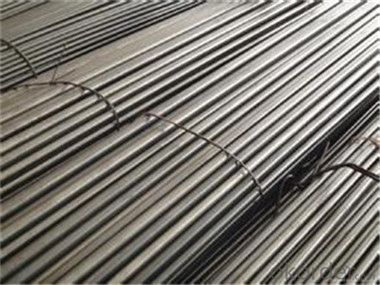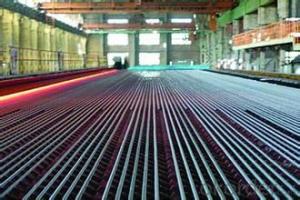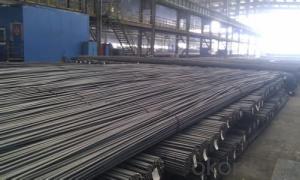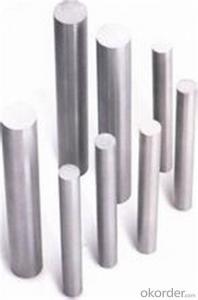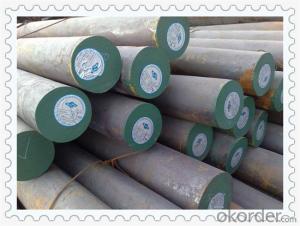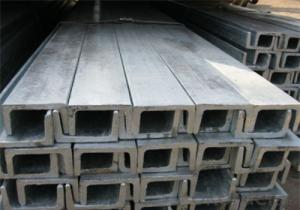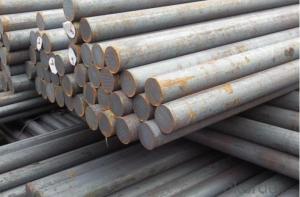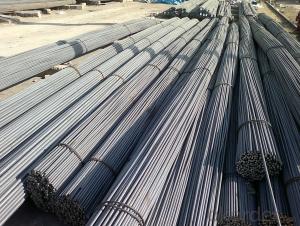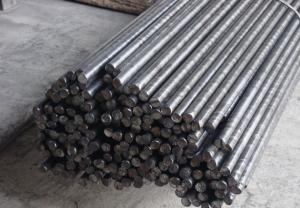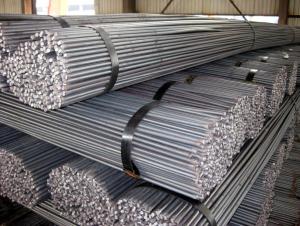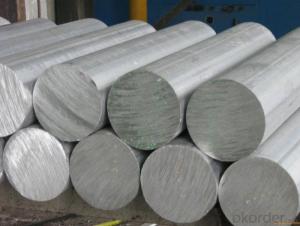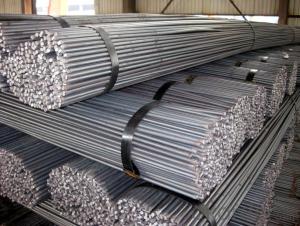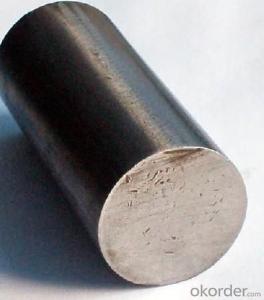A36 Steel Round Bars from China with High Quality
- Loading Port:
- Shanghai
- Payment Terms:
- TT OR LC
- Min Order Qty:
- 500 m.t.
- Supply Capability:
- 2000000 m.t./month
OKorder Service Pledge
OKorder Financial Service
You Might Also Like
Description of steel round bar:
1.Diameter 80 to 800 mm
2.Black or Bright surface
3.Annealed or Quenched and tempered provided
4.Cutting service provide. Carbon steel rod applies to chemical industry, shipping industry,
manufacturing industry,construction,decorate Industry,electric power,
pump shafts, sanitary wares,furniture handles,boiler,high temperature
resistant,low temperature resistant, corrosion resistant.
Festures of steel round bar:
4340 Forged Round Steel Bar
1.Dia 80-800mm Length:2000-13000mm or as required
2.Technique:Forged
3.Delivery Time:45 days
Specifications of steel round bar:
1. Standards: AISI 4340 8620 8640 4320 , JIS SNCM8 GB:40CrNiMoA
2. Specification: Dia: 80~450mm Length:2000-13000mm or as required
Images of steel round bar:
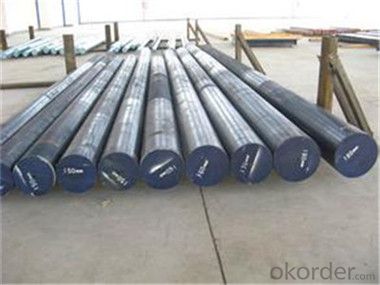
FAQ:
1. What is your package?
Packing situation: standard seaworthy packing or as customer required.
2. How long is the lead time?
Delivery time: 45 days after order confirmed.
3. What payment term do you accept?
Payment: T/T or L/C at sight.
- Q: What are the considerations for selecting the right steel grade for a round bar?
- When selecting the right steel grade for a round bar, there are several considerations to be taken into account. Firstly, it is important to consider the intended application of the round bar. Different steel grades have varying properties that make them suitable for specific purposes. For example, if the round bar will be used in a high-temperature environment, a steel grade with excellent heat resistance such as stainless steel or high-alloy steel would be ideal. On the other hand, if the round bar will be used in structural applications, a steel grade with good strength and ductility, such as carbon steel, may be more appropriate. Another consideration is the desired mechanical properties of the round bar. This includes factors such as the required tensile strength, yield strength, hardness, and toughness. These properties can vary significantly between different steel grades, so it is important to choose a grade that meets the specific requirements of the application. The corrosion resistance of the steel grade is also an important consideration. If the round bar will be exposed to corrosive environments, such as in marine or chemical applications, a stainless steel grade with high resistance to corrosion would be recommended. Alternatively, if corrosion resistance is not a major concern, a carbon steel grade may be more cost-effective. Cost is another factor that should be taken into consideration when selecting a steel grade for a round bar. Different steel grades have varying costs based on factors such as availability, demand, and manufacturing processes. It is important to balance the desired properties of the round bar with the available budget to ensure cost-effectiveness. Furthermore, it is important to consider the manufacturability of the steel grade. Some steel grades may be more difficult to machine or weld, which can impact the production process and cost. It is important to choose a steel grade that is readily available and can be easily processed to meet the required specifications. Lastly, it is always advisable to consult with steel suppliers, engineers, or metallurgists to ensure that the chosen steel grade aligns with the specific requirements of the application. They can provide valuable insights and recommendations based on their expertise and experience in the industry.
- Q: What are the advantages of using nickel-chromium-cobalt alloy steel round bars?
- There are several advantages of using nickel-chromium-cobalt alloy steel round bars. Firstly, this type of alloy steel has excellent corrosion resistance properties. It can withstand extreme environments, such as high temperatures, humidity, and exposure to chemicals, without succumbing to rust or corrosion. This makes it ideal for applications in industries like aerospace, marine, and chemical processing, where durability and longevity are crucial. Secondly, nickel-chromium-cobalt alloy steel round bars possess exceptional strength and toughness. They have a high tensile strength and can withstand heavy loads and impacts without deforming or breaking. This makes them suitable for applications that require structural integrity and resistance to deformation, such as in the construction industry or in manufacturing heavy machinery. Moreover, this alloy steel exhibits excellent heat resistance. It can withstand elevated temperatures without losing its mechanical properties, making it ideal for applications that involve high-temperature environments, such as in power generation, oil and gas exploration, or furnace components. Additionally, nickel-chromium-cobalt alloy steel round bars offer good wear resistance. They can withstand abrasive conditions, such as friction and wear, without experiencing significant deterioration. This makes them suitable for applications like tooling, machining, and wear components, where durability and resistance to wear are critical. Lastly, nickel-chromium-cobalt alloy steel round bars are highly versatile. They can be easily machined, welded, and formed into various shapes, making them adaptable to a wide range of applications. Their versatility allows for customization and flexibility in design and manufacturing processes. In conclusion, the advantages of using nickel-chromium-cobalt alloy steel round bars include excellent corrosion resistance, high strength and toughness, heat resistance, good wear resistance, and versatility. These qualities make them a preferred choice for various industries, where reliability, durability, and performance are essential.
- Q: Can steel round bars be extruded?
- No, steel round bars cannot be extruded. Extrusion is a manufacturing process that involves forcing material through a die to create a specific shape or profile. While steel can be extruded into various shapes, such as tubes, channels, or angles, round bars are typically not produced by extrusion. Instead, steel round bars are usually made through a different process called hot rolling, where a cylindrical billet is heated and passed through a series of rollers to achieve the desired diameter and length.
- Q: Can steel round bars be bent or formed?
- Steel round bars have the capability to be bent or formed, depending on several factors such as the type of steel, bar diameter and thickness, and the chosen bending or forming method. There are various techniques available for bending or forming steel round bars, including hot bending, cold bending, and mechanical bending. In hot bending, the steel round bar is heated to a specific temperature and then shaped according to the desired form. On the other hand, cold bending does not require any heating and can be accomplished using hydraulic or manual bending machines. Mechanical bending, however, involves the utilization of specialized machinery to apply force and bend the steel round bar. It is vital to note that excessive bending or forming may weaken the steel round bar and affect its structural integrity. Hence, it is crucial to adhere to proper bending and forming techniques and consider the manufacturer's limitations and industry standards.
- Q: What are the tolerance levels for steel round bars?
- The tolerance levels for steel round bars can vary depending on the specific requirements and industry standards. Generally, the tolerance levels for diameter can range from +/- 0.001 inches to +/- 0.005 inches, while the tolerance levels for length can range from +/- 0.125 inches to +/- 0.250 inches. It is important to refer to the relevant specifications or consult with a manufacturer to determine the specific tolerance levels for a particular steel round bar.
- Q: Can steel round bars be used for making mining equipment?
- Certainly! Mining equipment can indeed be made using steel round bars. These bars, owing to their exceptional strength, durability, and resistance to wear and tear, are widely utilized in the manufacturing process of various mining equipment. They are particularly suitable for applications that demand robust and heavy-duty machinery, such as drilling rigs, excavators, crushers, and conveyor systems employed in the mining industry. The adaptability of steel round bars enables them to be machined, welded, and shaped into diverse forms and sizes, thus facilitating the customization of mining equipment to cater to specific requirements. Moreover, steel round bars exhibit remarkable resilience in mining environments, enduring exposure to abrasive substances, extreme temperatures, and substantial loads.
- Q: Can steel round bars be used in the manufacturing of bicycles?
- Indeed, bicycles can be manufactured using steel round bars. These bars are commonly utilized in multiple aspects of bicycle construction, including the frame, handlebars, cranksets, and seatposts. Steel, being a robust and enduring material, can withstand the strains and pressures associated with cycling. Moreover, it is comparatively affordable when compared to alternatives like carbon fiber. By employing steel round bars, the necessary strength and stability required for a bicycle's structural components are guaranteed, thereby ensuring a secure and dependable ride. Furthermore, steel can be easily manipulated and shaped to conform to the specific design prerequisites of a bicycle, making it a versatile material for manufacturing purposes. All in all, the bicycle industry frequently favors steel round bars due to their resilience, sturdiness, and cost-effectiveness.
- Q: Three - grade thread Phi 10 steel can replace a grade Phi 12 round bar? Which elder knows, trouble pointing.
- Notes on reinforcement replacement1, steel replacement, to understand the design intent, the important components of the steel replacement, with the consent of the design unit (the actual: to change the design units should be agreed).2, steel replacement, should meet the minimum reinforcement ratio requirements and reinforcement structure (such as minimum steel reinforcement diameter, spacing, root number, anchorage length, etc.) provisions. The bar as possible with the original design of root number.3, crack resistance requirements of the components (such as crane beam, truss bottom chord, etc.) with smooth steel (not reinforced grade) instead of rebar.4, do not change the effective height of the component.
- Q: What is the difference between a polished and a cold drawn steel round bar?
- A polished steel round bar is a steel bar that has undergone a polishing process. This process involves using abrasive materials to remove any surface imperfections and create a smooth, shiny finish. The purpose of polishing is to enhance the visual appearance and corrosion resistance of the steel bar. It is commonly used for decorative or architectural purposes where aesthetics are important. On the other hand, a cold drawn steel round bar is produced using a different manufacturing process. In this method, a steel bar is pulled through a die at room temperature to reduce its diameter and increase its length. This process results in a bar with a more precise and uniform diameter, as well as improved mechanical properties such as higher tensile strength and dimensional accuracy. Cold drawing also improves the surface finish, although it may not achieve the same level of smoothness and shine as a polished bar. In summary, the main distinction between a polished and a cold drawn steel round bar lies in the manufacturing process and the resulting properties. Polishing is done for aesthetic purposes, creating a smooth and shiny finish. On the other hand, cold drawing is performed to enhance the dimensional accuracy and mechanical properties of the steel bar.
- Q: What are the different standards for steel round bars?
- There are several different standards for steel round bars, which vary by country and industry. Some of the commonly used standards include: 1. ASTM A36: This standard is widely used in the United States and specifies the requirements for carbon structural steel, including round bars. It covers the chemical composition, mechanical properties, and dimensional tolerances of the steel. 2. EN 10025: This European standard covers structural steel, including round bars, and is used in many European countries. It defines the chemical composition, mechanical properties, and technical delivery conditions for the steel. 3. JIS G3101: This Japanese standard is commonly used in Asia and specifies the general requirements for hot-rolled steel, including round bars. It covers the chemical composition, mechanical properties, and dimensional tolerances of the steel. 4. DIN 17100: This German standard is widely used in Germany and other European countries. It defines the general structural steels, including round bars, and provides details on the chemical composition, mechanical properties, and technical delivery conditions. 5. BS 970: This British standard covers various types of steel, including round bars, and provides specifications for their chemical composition, mechanical properties, and dimensional tolerances. These are just a few examples of the many standards for steel round bars. It's important to consult the appropriate standard for specific applications to ensure the desired properties and quality of the steel.
Send your message to us
A36 Steel Round Bars from China with High Quality
- Loading Port:
- Shanghai
- Payment Terms:
- TT OR LC
- Min Order Qty:
- 500 m.t.
- Supply Capability:
- 2000000 m.t./month
OKorder Service Pledge
OKorder Financial Service
Similar products
Hot products
Hot Searches
Related keywords


